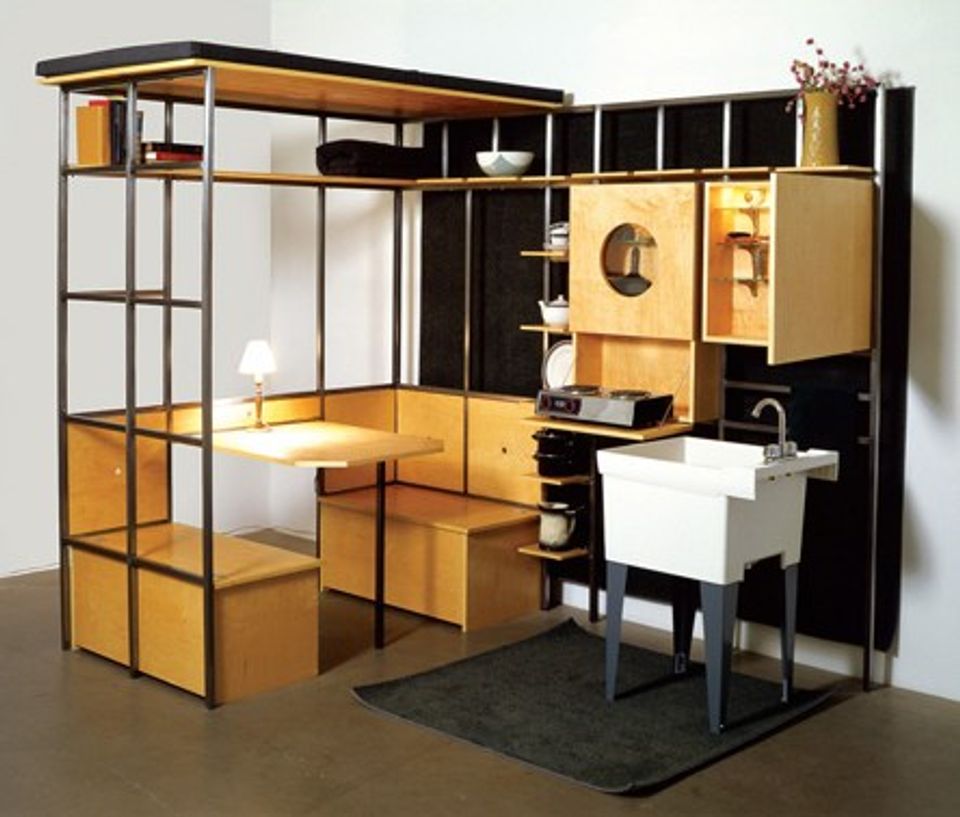
Andrea Zittel, A-Z Management and Maintenance Unit Model 003, 1992, Steel, wood, carpet, plastic sink, stove top, mirror, 86 x 94 x 68 inches, ©Andrea Zittel, Image courtesy of the Andrea Rosen Gallery, NY
When I take my roadtrip one day through the American Southwest to see its many site-specific earth artworks, the last stop will be the furthest frontier in American earth art: Joshua Tree, California. While Michael Heizer plows his City, and James Turrell burrows Roden Crater*—two monumental earth sites that have been in the hopper for decades now—Andrea Zittel is turning Joshua Tree into a new category of earthwork altogether.
Zittel, the winner of the Smithsonian American Art Museum 2005 Lucelia Artist Award, worked from 1994 to 1998 in a storefront space in Brooklyn called A–Z East. Here she gradually replaced the commercial objects that could conceivably enter into a residence or workspace with her own meticulously manufactured art objects—from clothing to climate-controlled chambers. The artist relocated the headquarters for her “designs for living” to her home state of California several years ago; A–Z West in Joshua Tree might be considered the outlet for her “outdoors” line.
If you’ve seen “Critical Designs” solo exhibition of her work (either recently at the Contemporary Arts Museum Houston or currently at the New Museum in New York), you may well object to a characterization of her work as site-specific “earth art.” Fair enough: the scope of her designs encompasses roles and obligations in Western societies, the psychology behind commercial production, and the economy.
Yet Zittel’s High Desert Test Sites sees her totalistic approach to an individual’s surroundings applied to the environment. The project’s mission is to “challenge traditional conventions of ownership, property and patronage,” which are merely other aspects of personal economy—but writ to the land. In that sense the project falls under that site-specific earthwork column, if perhaps loosely; her micro-economy focus deviates from the macro-scale works of the 1960s, and Zittel’s are not nearly as permanent.
Nevertheless, for Zittel, the sublime is a significant draw. The artist describes her relationship to the site of A–Z West:
This desert region originally appealed to us because it seemed that one could “do anything here”—which we are finding out isn’t exactly true! It is also the historical site of the five-acre Homestead Act. In the 1940s and 50s legislation gave people 5 acres of land for free if they could improve it by building a minimal structure. The result is a seemingly infinite grid system of dirt roads that cuts up a very beautiful desert region. In the middle of each perfect square of land is a tiny shack—most of them long since abandoned. The area and its history represent a very poignant clash of human idealism, the harshness of the desert climate and the vast distances that it places in between people.
As nature reclaims the relics of civilization, those artifacts become part and parcel to nature (I’m thinking here of Edward Burtynsky’s landscape photography). By acknowledging those relics and their history as being massive and beyond reach—on the scale of a desert or sea—Zittel’s Joshua Tree matches the tenor of other works tied to the Southwest.
* The unfinished Web page about the unfinished earthwork delivers the clever pun: "Site under construction."
















